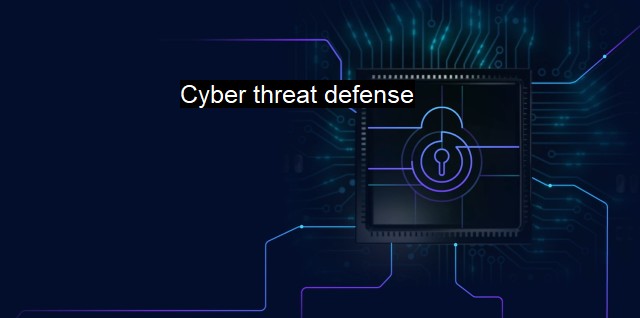What is Cyber threat defense?
Cyber Threat Defense: Understanding the Role of Antivirus in Modern Cybersecurity.
Cyber threat defense refers to the measures and strategies dedicated to identify, analyze, and mitigate potential threats to a system's integrity or an individual’s data. With an increasing dependency on digital resources and the internet in the present era, maintaining the protection of our networks and personal information has become a paramount concern. This is where cyber threat defense comes into play.Cyber threat defense focuses on the defense of networks, computers, and data from disruption or unauthorized access. It's the prevention and response to various actions conducted typically by malicious parties known as, black hat hackers. Such actions aim to disable, compromise, or exploit a computer system and its associated networks for multiple purposes including data theft, damage, and extraction of sensitive information.
In a broader definition, cyber threat defense encompasses understanding the types of threats in the digital sphere, the potential targets, and the approaches to secure those targets. Globally, threats can be sourced from individuals with malicious intent, organized cybercriminal groups, state-sponsored hackers, employee lapse, sabotage, and many others. The effects can range from inconveniences to losing millions of dollars and assets or even worst cybersecurity breaches that compromise national security.
Cyber threat defense includes implementing multiple strategies that collectively assist in securing systems and networks. Firewalls represent the first line of defense. These are designed either to permit or deny programmed transmissions from crossing networks, therefore acting as a barricade against unwanted intrusions. Intrusion detection systems (IDS) or intrusion prevention systems (IPS) monitor networks or systems for malicious activities and thereafter generate reports for a coordinated response.
The role of antivirus software shouldn’t be underestimated in the realm of cyber threat defense. Antivirus software is essential in watchdogging potential malicious activities in the view to guarding the computer systems and networks. It can identify, quarantine, and eliminate threats leading to the prevention of further spreading of viruses or harmful software.
But a comprehensive cyber threat defense solution goes beyond these. It involves measures like regular software upgrades and patches, network hardening, encryption of sensitive data, strengthened authentication processes, and disaster recovery plans.
Training and education of employees in recognizing potential threats are considered just as important to the framework. A key emphasis here is on phishing and other social engineering techniques which exploit human psychology to deceive and invade network systems.
There is also importance in implementing robust practices like default-deny (anything not expressly permitted is denied), least privilege (the minimal rights necessary to perform work), and separation of duties (distributing tasks among multiple individuals to prevent central control and power).
Lastly, deployed to wrangle massive volumes of data, artificial intelligence in the form of machine learning algorithms is lending more power to cyber threat defense by predicting behaviors, patterns, and anomalies.
There is no such thing as a foolproof system. Cyber threats evolve in sophistication at a rapid pace and novel ones appear every day. Therefore, appropriate cyber threat defenses need to progressively adapt and improve their capability as per the constantly changing realm of cyber threats. It's a game of cat and mouse, and standing still allows the adversaries to catch up and cause damage.
Cyber threat defense as an aspect of cybersecurity means establishing protective measures and efforts to absorb and counter the pool of potential threats in cyberspace. This involves both the identification of threats and their timely management, in conjunction to maintaining the confidentiality, integrity, and availability of digital environments. Cyber threat defense, therefore, sums up the technological and strategic constant struggle to stay one step ahead of potential adversaries. In the modern world bounded by technology and digital resources, it is an essential practice for all businesses and individuals alike.

Cyber threat defense FAQs
What is cyber threat defense?
Cyber threat defense refers to a set of practices, technologies, and strategies used to protect computer systems, networks, and sensitive data from cyber threats, such as viruses, malware, and hacker attacks.What is antivirus software?
Antivirus software is a type of cybersecurity tool that detects, prevents, and removes malicious software, such as viruses, worms, Trojans, and spyware, from a computer system. It scans files and data on the computer and compares them to a database of known threats to identify and eliminate any threats.Why is cyber threat defense important?
Cyber threat defense is essential because cyber threats are becoming increasingly common and sophisticated, and can cause significant damage to individuals, organizations, and even entire countries. A successful cyber attack can result in loss of sensitive data, financial loss, reputational damage, and even physical harm. Cyber threat defense helps to mitigate these risks and protect against potential attacks.What are some examples of cyber threat defense strategies?
Some examples of cyber threat defense strategies include implementing strong passwords and multi-factor authentication, keeping software and operating systems up to date with the latest security patches, using firewalls and intrusion detection systems, regularly backing up data, and providing cybersecurity training and awareness to employees.| | A | | | B | | | C | | | D | | | E | | | F | | | G | | | H | | | I | | | J | | | K | | | L | | | M | |
| | N | | | O | | | P | | | Q | | | R | | | S | | | T | | | U | | | V | | | W | | | X | | | Y | | | Z | |
| | 1 | | | 2 | | | 3 | | | 4 | | | 7 | | | 8 | | |||||||